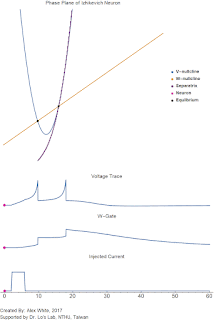Effects of altered EIB on DM in a cortical circuit model
Excitation/Inhibition balance has been shown to exist in neural networks, and is closely related to efficient coding and enhanced computational abilities. In this paper, the authors investigate the influence of disrupted E/I balance (EIB for short) in decision making (DM for short) tasks. To do so, they implemented NMDA hypofunction at two sites: inhibitory interneurons, which elevates E/I ratio via disinhibition, and excitatory pyramidal neurons, which lowers E/I ratio. Their result suggests that an elevated E/I ratio leads to impulsive decisions, while a lowered E/I ratio leads to indecisive DM.
Their study incorporates four DM tasks:
- Standard task: Random dots move to the left or to the right with different percentages. The subject (neural network) has to determine whether the majority moves to the left or right. The difficulty is controlled by a single parameter c, the coherence, which is 100% when all neurons move to the right, and 0% if it’s half-half in either direction. The authors then calculate the psychometric function, which is the correct DM percentage as a function of coherence.
- Psychophysical kernel task: The stimulation is segregated into different time bins, where each bin has a different coherence level drawn from a zero-mean uniform distribution. The authors then calculate the choice-triggered average, which reflects how each time bin influences the choice.
- Pulse task: An additional pulse at an adjustable time point is given in addition to the original stimulus. The shift in the psychometric function is given as a function of the pulse onset time.
- Duration task: The duration of the stimulus is varied.
The results of these four tasks present a unified picture. From the standard task, the authors observed that both elevated and decreased E/I ratio leads to worse performances. The activities reveal that an elevated E/I ratio circuit has faster ramping, and thus makes the decision without integrating over sufficient evidence. The reduced E/I ratio circuit faces the opposite problem, where it takes too long to decide, and often does not make one at all. The psychophysical kernel task proves the same point as the standard task. They then show that when E/I ratio is maintained, the absolute value of the synaptic weights does not influence the performance.
Author: Pei-Hsien Liu
Original paper: Lam, N. H., Borduqui, T., Hallak, J., Roque, A. C., Anticevic, A., Krystal, J. H., ... & Murray, J. D. (2017). Effects of altered excitation-inhibition balance on decision making in a cortical circuit model. bioRxiv, 100347.



留言
張貼留言